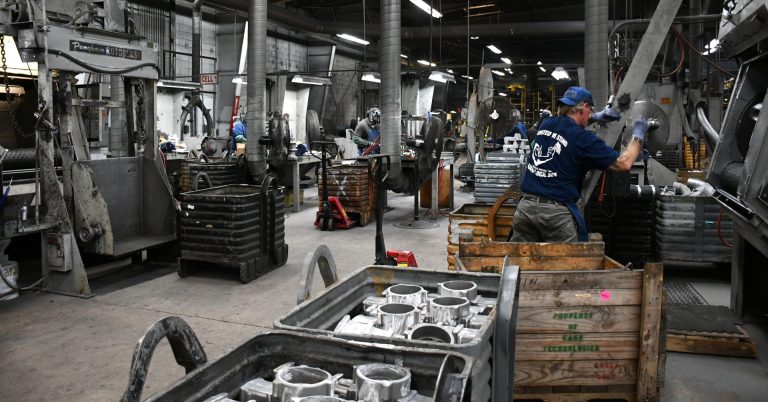Aluminum Casting Demystified: Trick Methods for Success
Aluminum Casting Demystified: Trick Methods for Success
Blog Article
The Top Methods for Light Weight Aluminum Casting That You Required to Know
From the conventional sand casting method to the intricate financial investment spreading procedure, each method provides distinct advantages that cater to various task demands. As we navigate through the top strategies for light weight aluminum casting, it becomes evident that understanding these approaches is vital for accomplishing optimum outcomes.
Sand Spreading Technique
The Sand Casting Strategy is an essential method in light weight aluminum spreading, extensively made use of for its cost-effectiveness and adaptability in creating intricate steel shapes. This strategy includes creating a mold and mildew made from compacted sand right into which molten aluminum is put, allowing it to strengthen and take the shape of the mold. Among the crucial advantages of sand spreading is its ability to create complex geometries with reasonably reduced tooling expenses, making it an appealing alternative for makers wanting to create unique elements.
In the sand spreading process, a pattern of the final part is pressed right into a great sand mixture had within a flask. Sand casting is frequently made use of in numerous industries, including automobile, aerospace, and art factories, due to its capability to generate both large and small metal elements with complex styles.

Financial Investment Casting Process
An intricate approach utilized in light weight aluminum casting is the Financial investment Casting Refine, known for its capacity to create very outlined and intricate steel components. Referred to as the lost-wax spreading process, this method dates back thousands of years and remains a prominent selection in various sectors due to its flexibility and accuracy.
The investment casting procedure begins with the development of a wax pattern, which is covered with a ceramic covering to form a mold. The wax is after that melted out, leaving a cavity in the shape of the desired component. Molten aluminum is poured right into the ceramic mold, taking and filling up the dental caries on the intricate details of the initial wax pattern.
This approach is favored for its capability to generate complex shapes with outstanding surface area coating and dimensional precision. It is commonly utilized in the production of aerospace parts, jewelry, and industrial machinery where complex styles are called for. The financial investment casting procedure offers high repeatability and can create parts with very little machining called for, making it a cost-efficient choice for many applications.
Permanent Mold Technique
Using a various strategy from the Financial investment Casting Refine, the Permanent Mold and mildew Approach in light weight aluminum spreading uses a distinctive strategy for developing steel elements. In this technique, a recyclable mold, usually constructed from steel or cast iron, is used to form the liquified light weight aluminum. The mold is preheated to a particular temperature before the aluminum is poured next page right into it. The warmth transfer from the liquified metal to the mold helps in strengthening the light weight aluminum swiftly, lowering the cooling time compared to sand casting.
One of the vital benefits of the Long-term Mold And Mildew Technique is the improved surface area finish and dimensional precision of the spreadings produced. This method is also recognized for its ability to generate high-strength aluminum parts with constant quality. try this In addition, the reusable nature of the mold and mildew makes it a cost-efficient option for tool to high volume manufacturing runs.
Die Spreading Technology
Using sophisticated production processes, pass away casting technology provides a very efficient method for creating complex aluminum parts. This method includes infusing molten aluminum into a steel mold and mildew, known as a die, at high pressures. The die is particularly designed to shape the aluminum right into the wanted kind, resulting in high accuracy and superb surface finish.
Die casting deals several advantages. It enables for the production of complex forms useful link with slim wall surfaces, limited resistances, and smooth surface areas, making it ideal for applications where aesthetic appeals and accuracy are critical. Additionally, die casting enables fast production rates, decreasing general manufacturing time and costs.

Lost Foam Spreading Method
Die casting innovation's efficiency and accuracy in generating light weight aluminum parts lead the means for discovering the Lost Foam Spreading Approach as a corresponding production method. Lost Foam Spreading, likewise understood as evaporative pattern casting, is a method that uses foam patterns to develop elaborate aluminum parts.
One of the vital benefits of Lost Foam Casting is its capability to produce intricate styles with detailed information that might be testing to achieve with conventional spreading methods. As sectors continue to demand light-weight yet long lasting components, Lost Foam Spreading proves to be a beneficial method in the world of aluminum casting.
Final Thought
Finally, recognizing the top methods for light weight aluminum casting is critical for achieving high-grade cause the manufacturing process. Sand spreading, financial investment casting, long-term mold and mildew, die casting, and shed foam spreading are all reliable methods for generating aluminum get rid of various degrees of complexity. By grasping these methods, suppliers can guarantee that their products satisfy the desired specs and criteria for efficiency and resilience.
From the standard sand spreading approach to the intricate investment casting procedure, each method uses special benefits that provide to various task requirements.The Sand Casting Technique is an essential approach in aluminum casting, widely used for its cost-effectiveness and adaptability in producing complex steel forms. Lost Foam Spreading, likewise recognized as evaporative pattern spreading, is an approach that makes use of foam patterns to develop detailed light weight aluminum components. As sectors proceed to require lightweight yet resilient elements, Lost Foam Casting shows to be an important technique in the realm of aluminum casting.
Sand spreading, financial investment casting, irreversible mold and mildew, pass away spreading, and lost foam casting are all reliable approaches for generating light weight aluminum parts with different degrees of intricacy.
Report this page